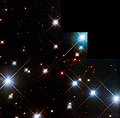This article needs additional citations for verification .(June 2024) |
| NGC 6231 | |
|---|---|
 NGC 6231 (top) with Zeta2 and Zeta1 Scorpii (bottom) | |
| Observation data (J2000.0 epoch) | |
| Right ascension | 16h 54.2m |
| Declination | −41° 48′ |
| Distance | 5,600±400 ly (1,700±130 pc [1] ) |
| Apparent magnitude (V) | 2.6 |
| Apparent dimensions (V) | 15.0′ |
| Physical characteristics | |
| Estimated age | 2–7 million years [2] [3] |
| Other designations | NGC 6171, Caldwell 76, Collinder 315, Melotte 153, De Cheseaux 9, Dunlop 499, Ha. I.7, Lacaille II.13 |
| Associations | |
| Constellation | Scorpius |
NGC 6231 (also known as Caldwell 76 or the Baby Scorpion Cluster [4] [5] ) is an open cluster in the southern sky located half a degrees north of Zeta Scorpii. NGC 6231 is part of a swath of young, bluish stars in the constellation Scorpius known as the Scorpius OB1 association. [6] The star Zeta1 (HR 6262) is a member of this association, while its brighter apparent partner, Zeta2 (HR 6271), is only 150 ly from Earth and so is not a member.[ citation needed ]
Contents
This cluster is estimated to be about 2–7 million years old, [2] [3] and is approaching the Solar System at 22 km/s. The cluster and association lie in the neighboring Sagittarius Arm of the Milky Way. Zeta1 Scorpii (spectral type O8 and magnitude 4.71. [7] ) is the brightest star in the association, and one of the most radiant stars known in the galaxy. [8] NGC 6231 was used to measure the binary fraction of B-type stars: 52%±8%, indicating that B-type stars are commonly found in binary systems, but not as commonly as in O-type stars. [3]
NGC 6231 also includes three Wolf-Rayet stars: HD 151932, HD 152270, [9] and HD 152408. [10]


